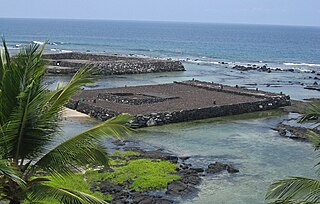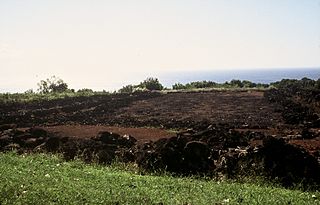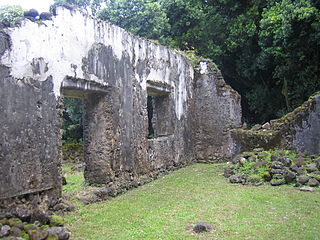Kahuna is a Hawaiian word that refers to an expert in any field. Historically, it has been used to refer to doctors, surgeons and dentists, as well as priests, ministers, and sorcerers.

Menehune are a mythological race of dwarf people in Hawaiian tradition who are said to live in the deep forests and hidden valleys of the Hawaiian Islands, hidden and far away from human settlements.

Laie is a census-designated place (CDP) located in the Koolauloa District on the island of Oahu in Honolulu County, Hawaii, United States. In Hawaiian, lāʻie means "ʻie leaf". The population was 5,963 at the 2020 census.

Waimea Bay is located in Haleiwa on the North Shore of O'ahu in the Hawaiian Islands at the mouth of the Waimea River. Waimea Valley extends to the east of Waimea Bay. Waimea means "reddish water" in Hawaiian.

Moanalua is a valley, a stream, an ahupuaʻa, and a residential neighborhood in Honolulu, Hawaiʻi. The valley extends inland from behind Āliapaʻakai crater to the crest of the Koʻolau Range.

Ancient Hawaiʻi is the period of Hawaiian history preceding the unification in 1810 of the Kingdom of Hawaiʻi by Kamehameha the Great. Traditionally, researchers estimated the first settlement of the Hawaiian islands as having occurred sporadically between 400 and 1100 CE by Polynesian long-distance navigators from the Samoan, Marquesas, and Tahiti islands within what is now French Polynesia. In 2010, a study was published based on radiocarbon dating of more reliable samples which suggests that the islands were settled much later, within a short timeframe, in about 1219 to 1266.
The following is an alphabetical list of articles related to the U.S. state of Hawaii:
Paʻao is a figure from Hawaii. He is most likely a Hawaiian historical character retold through Hawaiian legend. According to Hawaiian tradition and folklore, he is said to have been a high priest from Kahiki, specifically "Wewaʻu" and "ʻUpolu." In Hawaiian prose and chant, the term "Kahiki" is applied in reference to any land outside of Hawaii, the linguistic root is conclusively derived from Tahiti. "Wewaʻu" and "Upolu" point to actual places in, Tahiti, and Hawaiian scholars and royal commentators consistently claim Paʻao came from Tahiti.

Keaīwa Heiau State Recreation Area is the ruins of a temple at the summit of a hill and neighborhood called ʻAiea Heights on Oʻahu, Hawaiʻi. The recreation area includes camping facilities and a 4.8-mile (7.7 km) trail. It also offers clear views of Pearl Harbor. The high point of Puu Uau is about halfway down the trail, where native ohia lehua and koa trees may be viewed. The remains of a military plane that crashed in 1944 can also be seen along the trail. The hike is not particularly difficult, however it does include one quite steep switchback stretch and can be extremely muddy if it has just rained. Allow for around 2.5 hours of easy strolling. A possible translation of Keaʻiwa would be mysterious, incomprehensible. It is believed that this name was given in reference to the healing powers of the plants that no one could really explain. In addition, Keaiwa Heiau may have also been known as a "Heiau Hoʻola," or the healing or life-giving heiau according to native Hawaiian scholar Mary Kawena Pukui.

In ancient Hawaii, a luakini temple, or luakiniheiau, was a Native Hawaiian sacred place where human and animal blood sacrifices were offered.

Kohala Historical Sites State Monument includes the National Historic Landmark Moʻokini Heiau and the birthplace of Kamehameha I. It is located in remote North Kohala on the Island of Hawaiʻi.

A heiau is a Hawaiian temple. Made in different architectural styles depending upon their purpose and location, they range from simple earth terraces, to elaborately constructed stone platforms. There are heiau to treat the sick, offer first fruits, offer first catch, start rain, stop rain, increase the population, ensure the health of the nation, achieve success in distant voyaging, reach peace, and achieve success in war (luakini).

Puʻu o Mahuka Heiau State Historic Site on the North Shore of Oʻahu is the largest heiau on the island, covering 2 acres (8,100 m2) on a hilltop overlooking Waimea Bay and Waimea Valley. From its commanding heights, sentries could once monitor much of the northern shoreline of Oʻahu, and even spot signal fires from the Wailua Complex of Heiaus on Kauaʻi, with which it had ties. It was designated a National Historic Landmark in 1962, when it became the center of a 4-acre (16,000 m2) state park. It was added to the National Register of Historic Places in 1966.

Gideon Peleʻioholani Laʻanui (1797–1849) was a Hawaiian chief and the grandnephew of Kamehameha the Great, who unified the Hawaiian Islands in 1810. From him descends the House of Laanui.

Ulupō Heiau on the eastern edge of Kawai Nui Marsh in Kailua, Hawaiʻi, is an ancient site associated in legend with the menehune, but later with high chiefs of Oʻahu, such as Kakuhihewa in the 15th century and Kualiʻi in the late 17th century. It may have reached the peak of its importance in 1750, before being abandoned after Oʻahu was conquered in the 1780s. The site became a territorial park in 1954, was partially restored in the early 1960s, marked with a bronze plaque by the State Commission on Historical Sites in 1962, and listed on the National Register of Historic Places in 1972.
The original rulers of the Hawaiian islands were a line of native Hawaiians who were independent monarchs of various subdivisions of the land and islands of Hawaii. Their genealogy is traced to Hānalaʻanui and others. The caste system of ancient Hawaiian society was established around 1200 AD and separated the people into 4 distinct ranks that were all below the supreme ruler of the island. The ali‘i nui would distribute the land to the lower ranking chiefs who would run the land and collect offerings and taxes. The ali‘i nui would also ultimately be responsible for the sacred kapu, a system of rules designed to control social order. The noho ali‘i were known for their brightly colored and intricately constructed battle regalia of feathered capes and helmets called a mahiole (helmet) and ʻahu ʻula.
Hewahewa was a Hawaiian religious leader who served as kahuna nui of King Kamehameha I and his successor Kamehameha II. Hewahewa was a powerful figure in the royal court of Hawaii and played a major role in the abolition of the kapu system, the decline of the native religion of Hawaii, and the introduction of Christianity to the Hawaiian Kingdom.

Kaʻiana, also known as Keawe-Kaʻiana-a-ʻAhuʻula, was a Native Hawaiian warrior and aliʻi (noble) of Puna, Hawai‘i, who turned against Kamehameha I in 1795 during his conquest of Oahu and then sided with the island's ruler, Kalanikupule.


















